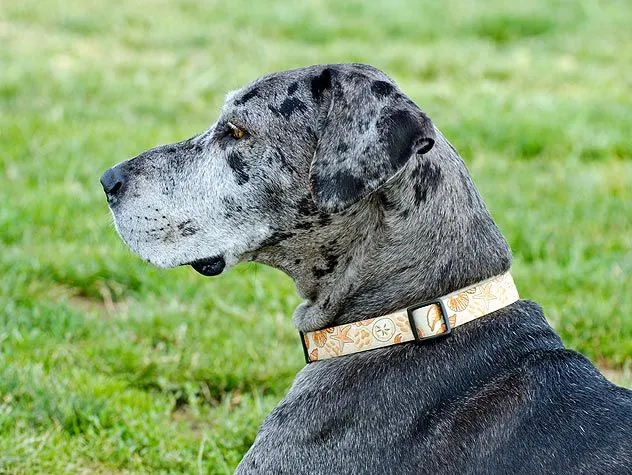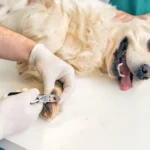Black skin disease in dogs is a term used to describe a condition where the skin of a dog becomes darkened or hyperpigmented, often accompanied by hair loss and other symptoms.
While it may sound alarming, it is a fairly common issue that can be managed with proper care and treatment. In this article, we will explore the causes, symptoms, treatment options, and prevention strategies for black skin disease in dogs, helping you understand how to keep your furry friend healthy and happy.
What Is Black Skin Disease in Dogs?
Black skin disease in dogs, also referred to as canine black skin disease or dark skin disorder in dogs, is characterized by the darkening of the skin, particularly in areas like the belly, legs, and underarms. This dark pigmentation is often the result of an underlying health issue, such as a hormonal imbalance, infection, or even allergies.
This condition is not an infectious disease, so your dog cannot spread it to other pets or humans. However, it can significantly affect your dog’s quality of life if not addressed properly. Black skin disease can range from mild cases, where the skin may darken slightly, to more severe instances that may result in hair loss, skin thickening, or even painful lesions.
Breeds Most Affected by Black Skin Disease
Certain breeds are more prone to developing black skin disease due to genetic factors or hormonal issues. These breeds include:
- Doberman Pinschers
- Chihuahuas
- Dachshunds
- Cocker Spaniels
- Schnauzers
- Poodles
These dogs are more susceptible due to inherited hormonal imbalances or other skin-related genetic factors. However, any dog can develop this condition, so it’s important to be aware of the symptoms regardless of breed.
Causes of Black Skin Disease in Dogs
The exact cause of black skin disease in dogs can vary. It is often linked to several underlying factors, ranging from hormonal imbalances to environmental triggers. Below are some of the most common causes:
-
Hormonal Imbalances
One of the most significant contributors to black skin disease in dogs is hormonal imbalances. These can result from conditions like:
- Hypothyroidism: This is a condition where the thyroid gland produces insufficient thyroid hormone, leading to skin issues, including black skin disease.
- Cushing’s Disease (Hyperadrenocorticism): When the adrenal glands produce too much cortisol, it can lead to skin changes, hair loss, and dark pigmentation.
- Sex Hormones: Imbalances in estrogen or testosterone can also lead to pigmentation changes and skin issues.
-
Allergies and Infections
Dogs with chronic allergies, whether to food, pollen, or environmental irritants, may develop black skin due to ongoing inflammation. Additionally, bacterial or fungal infections can trigger skin discoloration. These infections may cause irritation, hair loss, and changes in skin texture.
- Flea Allergies: Flea bites can cause allergic reactions, leading to skin discoloration and hair loss.
- Fungal Infections: Conditions like Malassezia dermatitis (a type of fungal infection) can lead to darkened, greasy skin.
-
Genetics and Breeding
Some dogs are genetically predisposed to developing skin conditions like black skin disease. This is especially true in breeds where skin pigmentation issues are common due to selective breeding.
-
Environmental Factors
Stress, poor diet, and exposure to harmful chemicals or toxins can also contribute to skin health problems. Dogs that live in a stressful environment or consume low-quality food may be more likely to develop skin conditions, including black skin disease.
Symptoms of Black Skin Disease in Dogs
Recognizing the symptoms of black skin disease in dogs is crucial for timely treatment. Here are the most common symptoms to watch for:
-
Hyperpigmentation
The hallmark symptom of black skin disease is hyperpigmentation, which refers to the darkening of the skin. The affected areas may appear black or gray and typically develop on the belly, legs, armpits, and around the neck. As the disease progresses, the pigmentation can spread to other parts of the body.
-
Hair Loss
Hair loss, or alopecia, is a common symptom of black skin disease. The fur may start to thin or fall out in patches, especially around the darkened areas of the skin. This occurs due to the underlying hormonal imbalances or infections affecting the skin and hair follicles.
-
Itching and Irritation
Dogs with black skin disease may scratch or lick their affected areas due to itchiness. This can be caused by inflammation, allergies, or infections in the skin. Chronic itching can lead to further damage to the skin, making the condition worse.
-
Changes in Skin Texture
As the condition progresses, the texture of the affected skin may change. It may become thickened, rough, or scaly. In some cases, you may notice the presence of bumps or cysts on the skin.
Diagnosing Black Skin Disease in Dogs
If you notice any of the symptoms mentioned above, it’s important to visit the veterinarian for a proper diagnosis. Diagnosing black skin disease in dogs typically involves:
- Physical Examination: Your vet will assess your dog’s skin and look for signs of pigmentation changes, hair loss, and inflammation.
- Blood Tests: Blood work can help identify hormonal imbalances, infections, or other underlying health conditions like hypothyroidism or Cushing’s disease.
- Skin Scraping and Biopsy: If an infection or other dermatological condition is suspected, your vet may take a skin scraping or biopsy to examine the skin cells under a microscope.
- Hormonal Tests: To diagnose conditions like hypothyroidism or Cushing’s disease, your vet may run hormone level tests.
Treatment Options for Black Skin Disease in Dogs
The treatment for black skin disease in dogs depends on the underlying cause. Here are the most common treatment options:
-
Medications
If the black skin disease is caused by a hormonal imbalance, your vet may prescribe medication to address the root cause:
- Thyroid medication for hypothyroidism.
- Corticosteroids to manage Cushing’s disease or inflammation.
- Antifungal or antibiotic treatments for infections.
-
Dietary Changes
A balanced diet is essential in managing skin conditions. If food allergies or nutritional deficiencies are contributing to your dog’s skin problem, your vet may recommend switching to a hypoallergenic dog food or adding supplements like Omega-3 fatty acids to improve skin health.
-
Topical Treatments
Topical treatments, such as medicated shampoos or creams, can help soothe the skin, reduce inflammation, and combat infections. Some shampoos are specifically designed to treat fungal infections or bacteria that may contribute to black skin disease.
-
Lifestyle Adjustments
To manage the condition at home, it’s important to create a stress-free environment for your dog. Regular grooming with gentle, hypoallergenic products, as well as keeping your dog’s living space clean and free of allergens, can also help manage the symptoms.
-
Surgical Interventions
In severe cases where the black skin disease leads to cysts or tumors, your vet may recommend surgical intervention. While this is not a common treatment, it may be necessary if there are growths that need to be removed.
Preventing Black Skin Disease in Dogs
Prevention is always better than cure, and there are several ways to reduce the risk of your dog developing black skin disease:
-
Genetic Considerations
When choosing a dog, be aware of any breed-specific health issues. If you are considering adopting a breed that is more prone to black skin disease, be sure to work with a responsible breeder who screens for genetic conditions.
-
Regular Vet Checkups
Routine veterinary visits are crucial in catching conditions like hormonal imbalances or infections before they develop into more serious problems. Regular blood tests can help monitor your dog’s health and prevent issues from escalating.
-
Healthy Lifestyle Practices
- Diet: Feed your dog a balanced, nutritious diet to support their overall health and skin condition.
- Exercise: Regular exercise is important for maintaining a healthy weight and reducing stress, both of which can impact skin health.
- Grooming: Regular brushing helps remove dirt and allergens from your dog’s fur, preventing skin irritation and infections.
Managing Your Dog’s Skin Health at Home
It’s important to keep an eye on your dog’s skin health, especially if they are prone to conditions like black skin disease. Here are some daily care tips to help manage your dog’s skin health at home:
- Daily Grooming: Brush your dog regularly with a gentle brush to remove loose fur and debris. This also helps stimulate circulation to the skin.
- Use Vet-Approved Products: Only use grooming products that are approved by your vet, especially if your dog has sensitive skin.
- Monitor Symptoms: If you notice any worsening symptoms, such as increased hair loss or skin irritation, take your dog to the vet immediately.
FAQs about Black Skin Disease in Dog
Q:What are the main symptoms of black skin disease in dogs?
A:The main symptoms of black skin disease include darkened skin (hyperpigmentation), hair loss, itching, and changes in skin texture.
Q:Can black skin disease in dogs be treated?
A:Yes, black skin disease can often be treated by addressing the underlying cause, whether it’s hormonal imbalances, infections, or allergies.
Q:Is black skin disease contagious to other dogs?
A:No, black skin disease is not contagious. It is caused by underlying health conditions, not by infection.
Conclusion
Black Skin Disease, or Alopecia X, remains a complex and challenging condition affecting various dog breeds. While its exact cause is not fully understood, genetic predisposition, hormonal imbalances, and potential environmental factors play significant roles.
Veterinary professionals typically manage the disease through comprehensive approaches including hormone testing, dietary modifications, skin treatments, and sometimes medication. Though the condition is primarily cosmetic and does not typically cause physical discomfort, it can impact a dog’s appearance and owner’s emotional well-being.
Ongoing research continues to explore the underlying mechanisms and potential targeted treatments. Early diagnosis, professional veterinary consultation, and a holistic management strategy offer the best outcomes for affected dogs.








